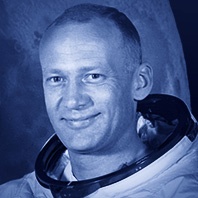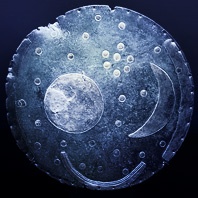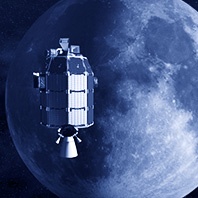Sir Charles Spencer Chaplin (1889–1977) is considered one of the first movie stars ever and made film history with his acting and his works. He is also one of the few artists who managed the transition from silent films to sound films.
Because of using archetypal imagery and symbols in his films, it is natural that the moon could also play a part somewhere. We found four references:
Read more
They have probably never met in person, Frank Sinatra (1915–1998), the American singer and entertainer and Sergei Rachmaninoff (1873–1943), the Russian pianist and composer, although, mathematically speaking, it might have been possible. However, almost two generations lay between both musicians and stylistically they are worlds apart. But there is a meeting point indeed, that even has to do with the full moon.
Read more
Buzz Aldrin (* 1930) is an American astronaut and the man, who, as part of the Apollo 11 mission on 21st July 1969, stepped onto the Moon as the second person, just after Neil Armstrong. He stood in the shadow of his colleague and one could assume that he may have suffered under these circumstances. But this was not the case, he did not really want to be in the spotlight and was satisfied coming second. After he set his feet into the dust 20 minutes after Armstrong did, he said: »Beautiful, beautiful. Magnificent desolation.«
Read more
Maybe it lies within the plan of creation that we are so susceptible to everything that is bigger than what we already know or have already experienced. However, the following merely relates to heavenly bodies …
As we recently wrote in our article »Sun and moon the same size?« here in our full moon blog, the moon changes its distance to earth due to its unusual orbit and subsequently appears to be of a different size for the observer here on earth, depending on how close it is to earth at the time. Is the moon (or another heavenly body) as close to earth as possible, one speaks of perigee, and if it is the furthest away, it is called apogee. You can confidently forget these terms again, however, you may want to memorise that the moon can appear to us in different sizes.
Read more
Just like with all natives from different countries and continents, the Moon also plays an important role amongst African peoples in myths and stories. In this respect, we have already mentioned other peoples, for example the Native American Indians in America, the Inuit in the far north or the Aborigines in Australia.
Read more
There is a German poem called “Dunkel war’s, der Mond schien helle“, in which the first line has been dedicated to the Moon and which boasts special features. For one thing, nobody knows who wrote the poem, which is quite unusual coming from the “land of poets and thinkers”. For another thing, it is based on the principle of the “oxymoron”. This is a figure of speech that juxtaposes elements that are contradictory or that are created from mutually exclusive terms. Straight away, the first line reveals this principle, because it cannot be “dark” when the Moon is shining “bright”.
Read more
The film is based on the book of the same title by Cressida Cowell (2003), was released in 2010 in movie theaters and became one of the most successful animations and earned nearly $500 million. Next to its impressive technical quality of the animation, it is most of all about the story of Hickup, a son of a Viking, who flies directly into the hearts of the audience, with his ability to tame dragons, which was a hostile skill to have up until then.
Read more
This disk, made of bronze and gold, with an age of around 3,600 years, belongs to the oldest find representing astronomical phenomena and thereby depicting planets and stars in the sky. It is thus of great value, because it is evidenced that people of the Bronze Age (2200-800 BC) did not only possess manual skills to create such a refined metal disk, but above all, had the knowledge about astronomical processes. They observed the celestial events with the naked eye and portrayed this in an artistic form.
Read more
When the sunlight appears on the Moon’s surface in a flat angle, interesting lighting effects are created, due to the mountains and valleys, which can be observed quite well from the Earth. A well-known effect is the so called »golden handle«. This is when the Jura Mountains (»Montes Jura«) are illuminated 4 to 5 days before the full moon and appear as a bright arc, in front of the still darkened Sea of Showers (»Sinus Iridum«) of the Mare Imbrium. This is reinforced by the fact that the boundary of light and shadow, which is called »terminator«, runs directly through this area.
Read more
Who doesn’t enjoy seeing a shooting star in the night sky? It is said that a wish is granted, which is believed to come true if kept secret and not shared with anyone. And who doesn’t want our wishes to become a reality?
To put it in physical terms, a shooting star is a »meteor«, a luminous effect, which develops with the occurrence of a »meteoroid« (a more or less large lump of rock from space), which burns up in the earth’s atmosphere. Not to be mistaken, however, with a »meteorite«. A meteoroid is only called like that, if it hits the earth’s surface (and could actually cause immense damage). So, no need to be concerned: shooting stars are harmless and very beautiful to watch.
Read more
As reported back in September 2013, NASA sent the lunar probe LADEE (short for: Lunar Atmosphere and Dust Environment Explorer) into space, to circle and to explore the Moon. Especially, the formation of ice at the lunar poles has been of great interest. The space probe also collected measurement data of dust particles and gases that are close to the Moon’s surface.
Read more










